Steel Products
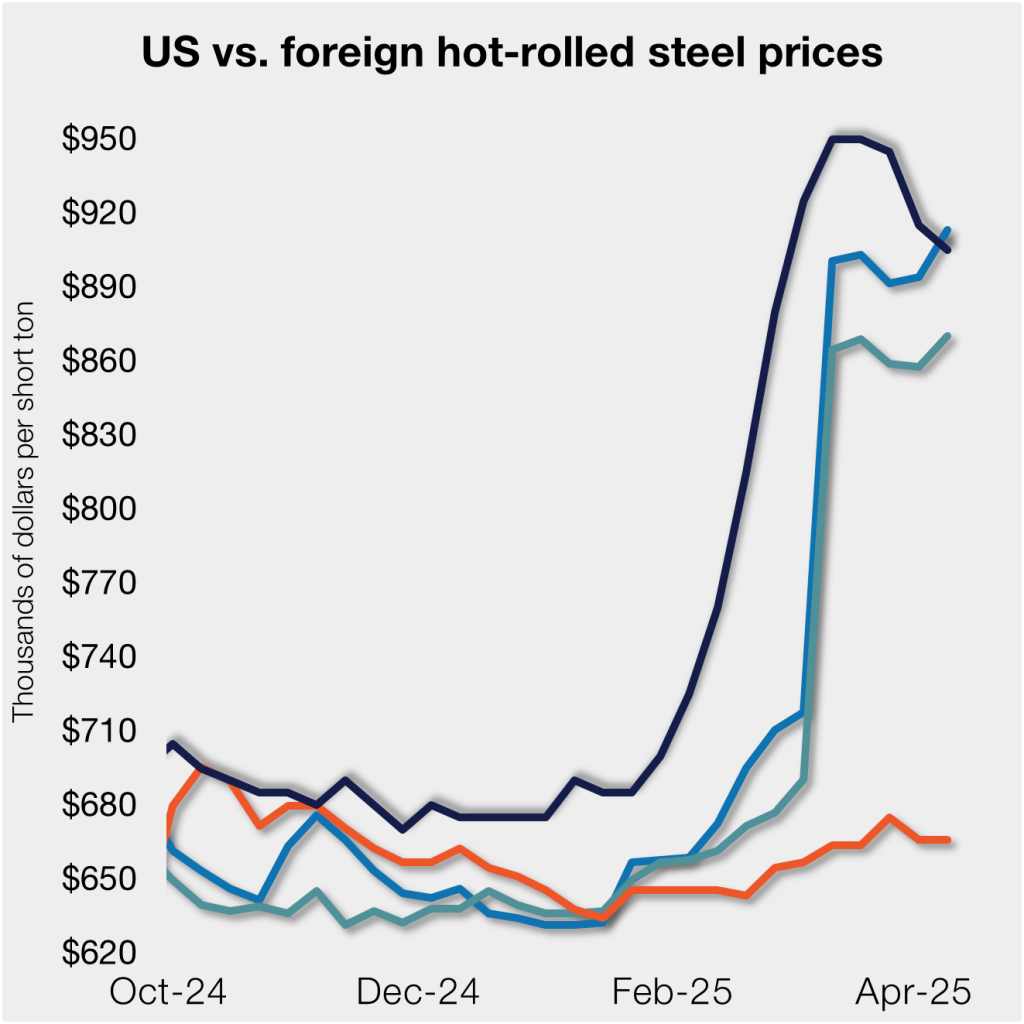
Return of S232 zapped gap between US and EU HR prices, Asian HR remains cheaper
Written by David Schollaert
April 9, 2025
Domestic hot-rolled (HR) coil prices declined this week for a third straight week. Most offshore markets bucked the trend and gained ground.
Uncertainty in the US market around tariffs, especially after “Liberation Day,” caused US prices to slip as buyers moved to the sidelines. It’s unclear to date whether the 90-day pause on the more extreme “reciprocal” tariffs, announced by President Trump on Wednesday, would see buyers return to the market.
Recall, too, that the re-emergence of Section 232 on March 12 narrowed the gap between imports and US prices on a landed basis. Before that date, allies such as Japan and the EU were not subject to the 25% S232 tariff.
By the numbers
This week, SMU’s average domestic HR price was $905 per short ton (st), down $10/st vs. the previous week.
The result: Domestic HR is now theoretically 9.8% more expensive than imported material, down from 11.9% last week. US HR was 25.5% more expensive than imports a month ago. That gap narrowed immediately after S232 took effect.
In dollar-per-ton terms, US HR is now, on average, $89/st more expensive than offshore product (see Figure 1). That’s roughly $20/st lower than the previous week.
The charts below compare HR prices in the US, Germany, Italy, and Asia. The left side highlights prices over the last two years. The right side zooms in to show more recent trends.
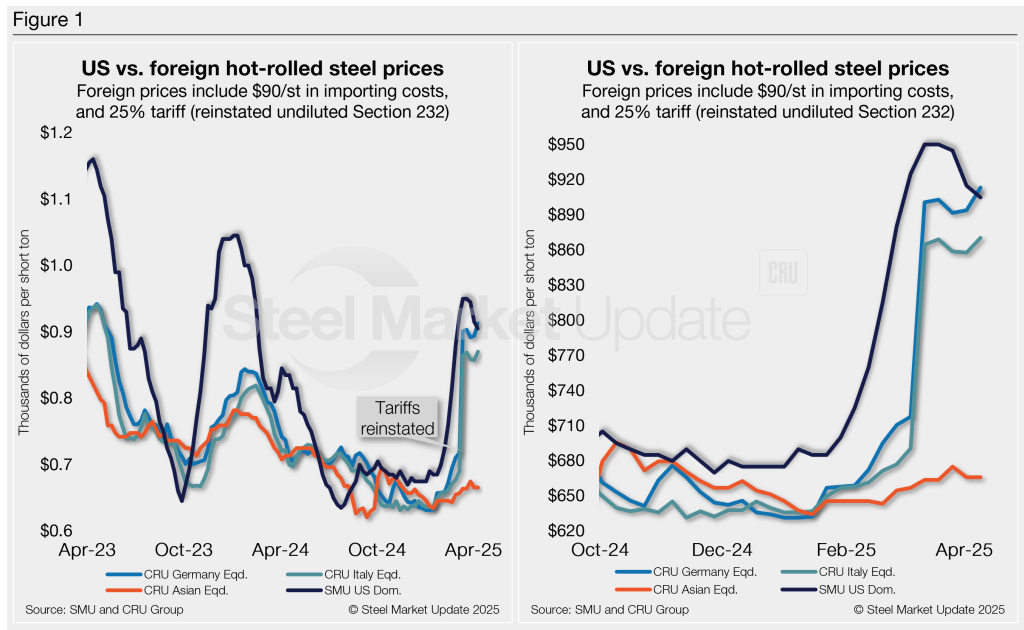
Methodology
SMU calculates the theoretical spread between domestic (FOB mill) and foreign (delivered to US ports) HR coil prices. We do this by comparing our weekly US HR assessment to CRU’s weekly HR indices for Germany, Italy, and East and Southeast Asian ports. This calculation is purely theoretical. Actual import costs can vary significantly and affect the true market spread.
To estimate the CIF price at US ports, we add a $90/st charge to all foreign prices to account for freight, handling, and trader margins, along with the 25% blanket tariff. This $90/st figure serves as a general benchmark — buyers should adjust it based on their specific shipping and handling expenses.
If you import steel and have insights on these costs, we’d love to hear from you. Contact the author at david@steelmarketupdate.com.
Asian HRC (East and Southeast Asian ports)
As of Wednesday, April 9, the CRU Asian HRC price was $461/st, flat vs. the week prior. Adding a 25% tariff and $90/st in estimated import costs, the delivered price of Asian HRC to the US is ~$666/st. As noted above, the latest SMU US HR price is $905/st on average.
The result: Prices for US-produced HR are theoretically $239/st higher than steel imported from Asia – $10/st lower week over week (w/w). The premium remains not far from recent highs seen in 2023 when stateside tags were ~$300 /st more expensive than Asian products.
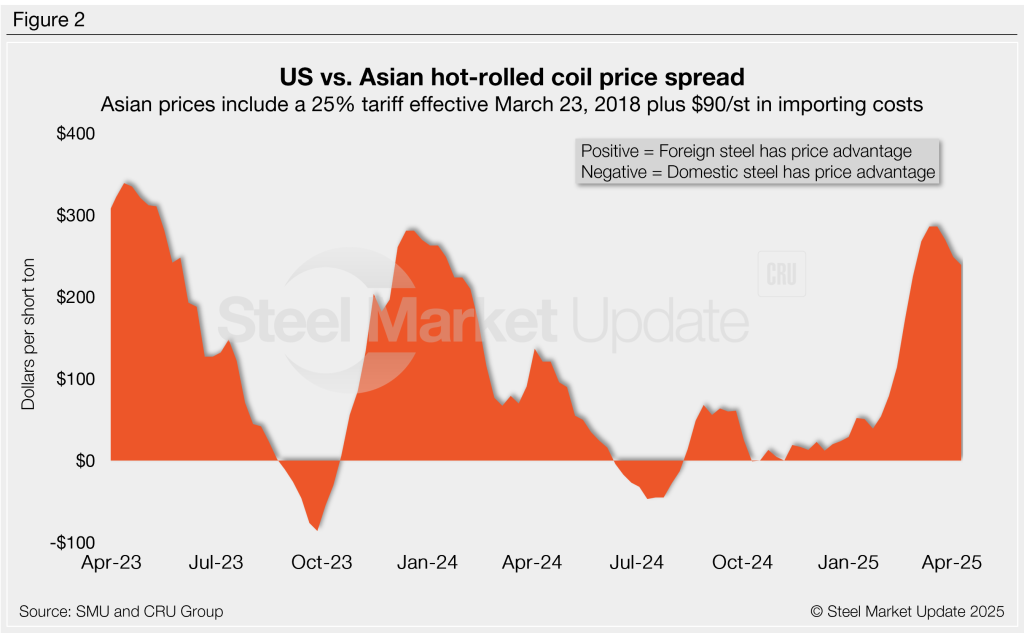
Italian HRC
Italian HR prices rose $10/st this week to $624/st, according to CRU. After reintroducing the 25% tariff and $90/st in estimated import costs, the delivered price of Italian HR is, in theory, $870/st.
That means domestic HR coil is theoretically $35/st more expensive than imports from Italy. That’s down $22/st w/w and represents a nearly a $200/st swing before S232 was reinstated. Without the 25% tariff, US prices were, in theory, $234/st above Italian imports.
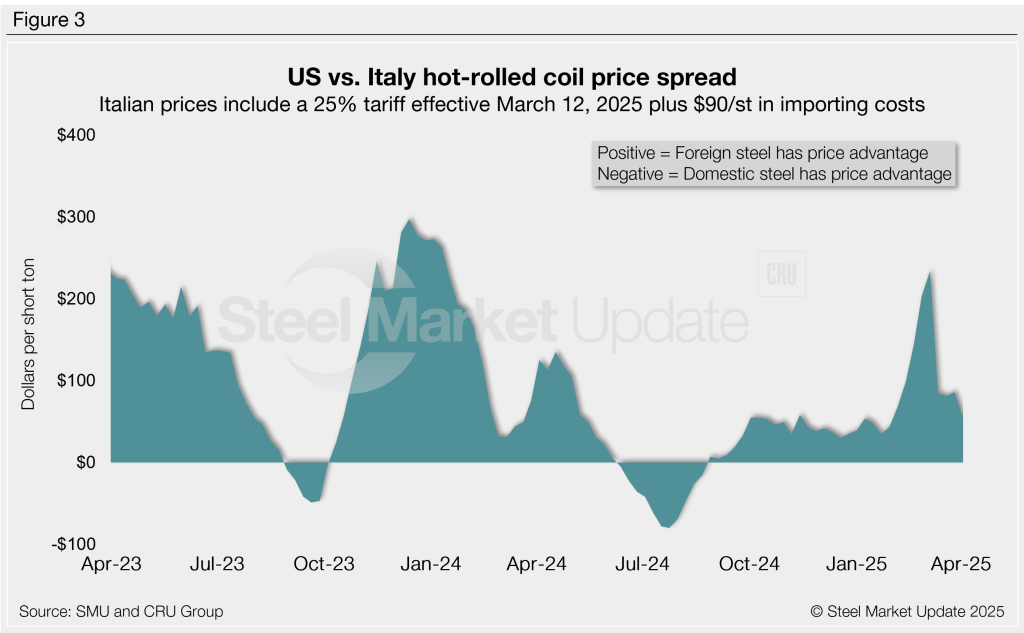
German HRC
CRU’s German HR price was up $16/st to $659/st this week. After adding a 25% tariff and $90/st in import costs, the delivered price of German HR coil is, in theory, $913/st.
The result: Domestic HR is theoretically now $8/st cheaper than HR imported from Germany, a $29/st swing vs. last week. Stateside hot band held a $207/st premium over German HR little more than a month ago – which had represented the widest margin in 14 months.
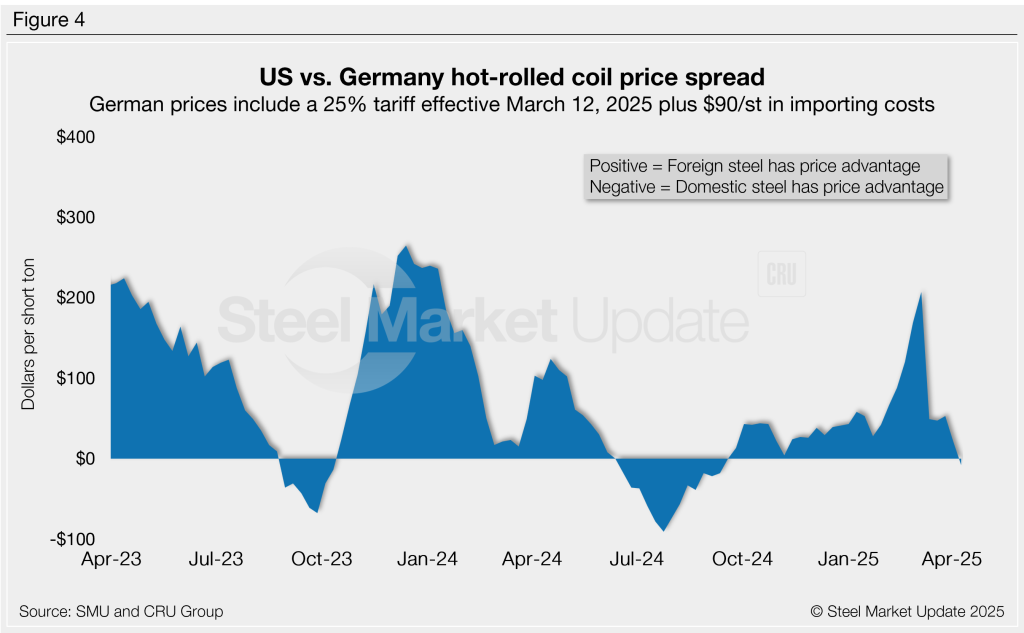
Editor’s note
Freight is important when deciding whether to import foreign steel or buy from a domestic mill. Domestic prices are referenced as FOB the producing mill. Foreign prices are CIF, the port (Houston, NOLA, Savannah, Los Angeles, Camden, etc.). Inland freight, from either a domestic mill or from the port, can dramatically impact the competitiveness of both domestic and foreign steel. It’s also important to factor in lead times. In most markets, domestic steel will deliver more quickly than foreign steel. Effective March 12, 2025, undiluted Section 232 tariffs were reinstated on steel. All steel imports and many derivative products now face a 25% tariff. Therefore, the German and Italian price comparisons in this analysis now include a 25% tariff. We do not include any antidumping (AD) or countervailing duties (CVD) in this analysis.

David Schollaert
Read more from David SchollaertLatest in Steel Products

CRU tariff webinar replay now available
CRU’s latest webinar replay on how Trump’s tariffs affect the global steel market is now available on our website to all members. After logging in at steelmarketupdate.com, visit the community tab and look under the “previous webinars” section of the dropdown menu. You’ll find not only this special CRU webinar but also all past Community […]
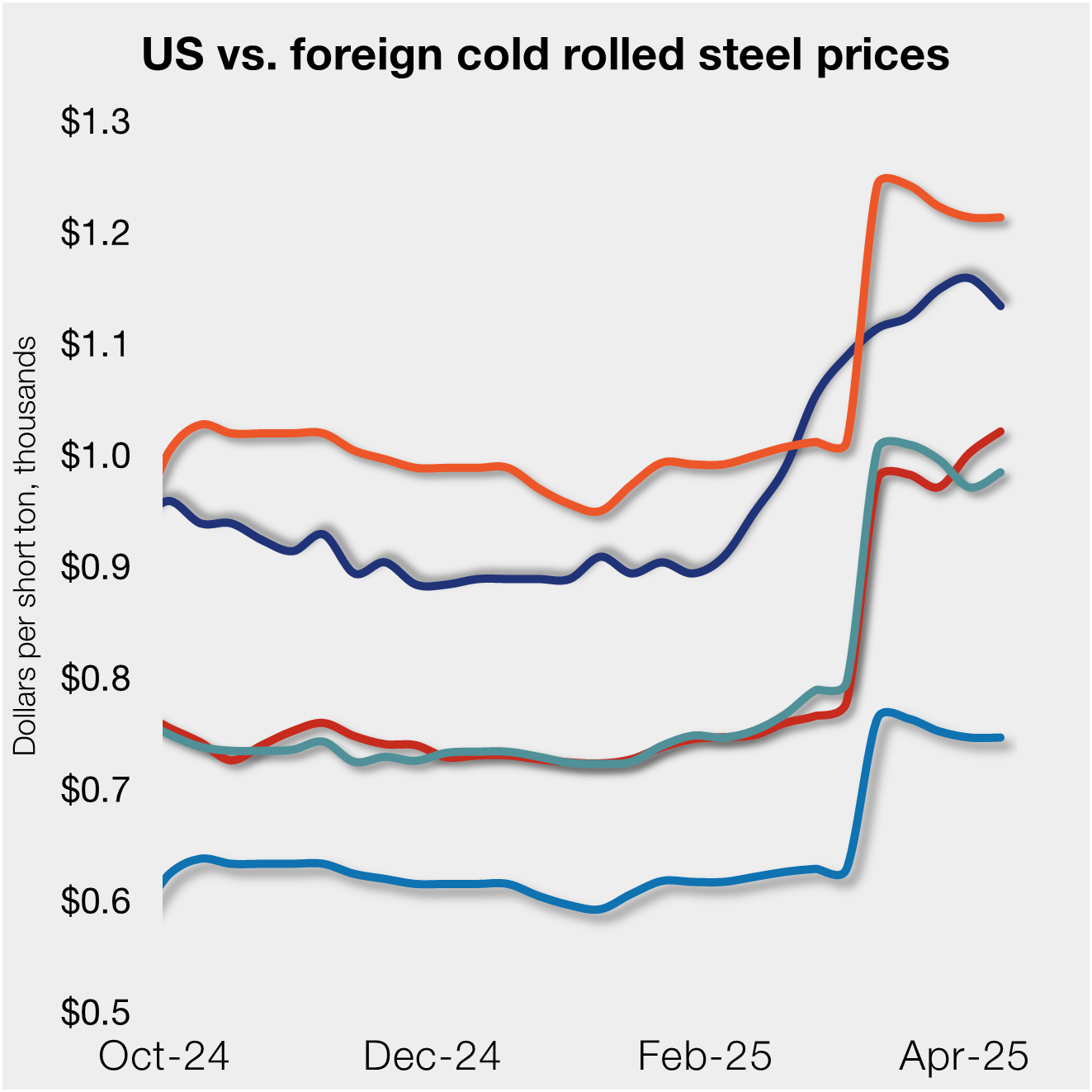
US, offshore CRC prices diverge
US cold-rolled (CR) coil prices declined this week, slipping for the first time since early February. Most offshore markets deviated, moving higher this week.
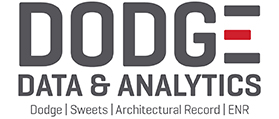
Construction growth slowed in March on tariff woes: Dodge
The decline comes after reaching a record high in January to kickstart the year.

SMU Steel Demand Index momentum slows further
SMU’s Steel Demand Index growth eased again, according to early April indicators. The slowdown comes after the index reached a four-year high in late February.
